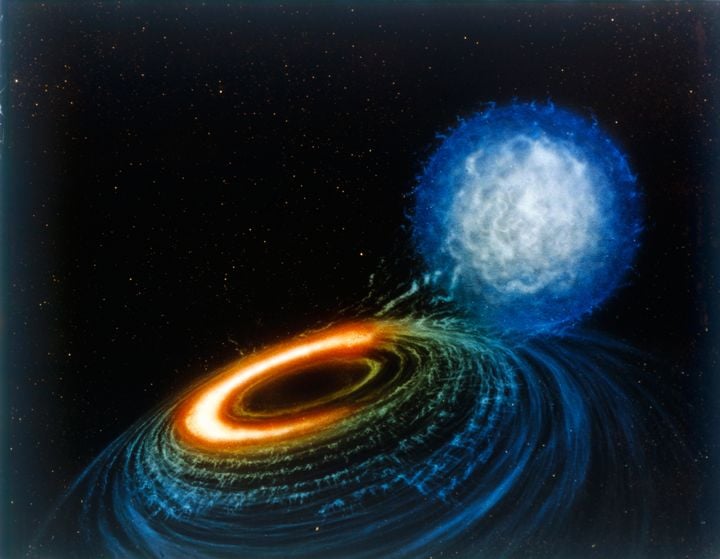Science
Queen’s University Researchers Unveil New Black Hole Study

Researchers from Queen’s University Belfast are embarking on a groundbreaking project to unravel the mysteries of black holes. The initiative, known as the Time Domain Extragalactic Survey (TiDES), aims to deepen understanding of how stars evolve and meet their end, particularly in relation to the enigmatic forces of black holes.
Over the next five years, a team of astronomers will conduct millions of detailed spectral observations of the night sky. Utilizing the state-of-the-art four-metre Multi-Object Spectroscopic Telescope (4MOST), installed on the VISTA telescope at the European Southern Observatory’s (ESO) Paranal Observatory in Chile, the researchers will capture light from cosmic objects across the spectrum.
The collaborative effort includes astronomers from across the UK, who will analyze extensive data on thousands of supernovae and other energetic cosmic events. This data will provide unprecedented insights into the behavior of stars, especially those that are influenced by the gravitational pull of black holes.
Dr. Matt Nicholl, one of the leading researchers on the project, expressed his enthusiasm: “Having access to this kind of data for tens of thousands of exploding stars and hungry black holes gives us a real opportunity to unlock some of the mysteries around how stars evolve and die.” The focus will particularly be on identifying stars that have been torn apart by medium-sized black holes, which are less massive than the supermassive black holes typically found at the centers of large galaxies.
Professor Stephen Smartt highlighted the project’s potential impact, stating, “This complex initiative could transform the understanding of how galaxies and black holes interact.” The TiDES project not only aims to find rare instances where stars are consumed by black holes but also to study the detailed chemical composition of these celestial bodies.
The 4MOST facility has recently obtained its first light, marking the beginning of an intensive search for unusual cosmic explosions. “Searching for unusual explosions and black holes is a bit like finding a needle in a galactic haystack,” Professor Smartt noted. The researchers plan to make high-precision measurements of nearly 1,000 supermassive black holes, 10,000 supernovae, and 100,000 galaxies.
TiDES will also allow UK astronomers to access data from the US National Science Foundation and the US Department of Energy’s Vera C. Rubin Observatory, through the Legacy Survey of Space and Time (LSST). This collaboration enhances the scope and depth of the research, promising to unlock new understanding in the field of astrophysics.
As the project progresses, the findings may not only shed light on the complex relationship between stars and black holes but could also lead to the discovery of new types of stellar explosions. The implications of this research are poised to significantly advance knowledge of the universe and its many mysteries.
-

 Health3 months ago
Health3 months agoNeurologist Warns Excessive Use of Supplements Can Harm Brain
-

 Health3 months ago
Health3 months agoFiona Phillips’ Husband Shares Heartfelt Update on Her Alzheimer’s Journey
-

 Science2 months ago
Science2 months agoBrian Cox Addresses Claims of Alien Probe in 3I/ATLAS Discovery
-

 Science2 months ago
Science2 months agoNASA Investigates Unusual Comet 3I/ATLAS; New Findings Emerge
-

 Science1 month ago
Science1 month agoScientists Examine 3I/ATLAS: Alien Artifact or Cosmic Oddity?
-

 Entertainment5 months ago
Entertainment5 months agoKerry Katona Discusses Future Baby Plans and Brian McFadden’s Wedding
-

 Science1 month ago
Science1 month agoNASA Investigates Speedy Object 3I/ATLAS, Sparking Speculation
-

 Entertainment4 months ago
Entertainment4 months agoEmmerdale Faces Tension as Dylan and April’s Lives Hang in the Balance
-

 World3 months ago
World3 months agoCole Palmer’s Cryptic Message to Kobbie Mainoo Following Loan Talks
-

 Science1 month ago
Science1 month agoNASA Scientists Explore Origins of 3I/ATLAS, a Fast-Moving Visitor
-

 Entertainment2 months ago
Entertainment2 months agoLewis Cope Addresses Accusations of Dance Training Advantage
-

 Entertainment3 months ago
Entertainment3 months agoMajor Cast Changes at Coronation Street: Exits and Returns in 2025









